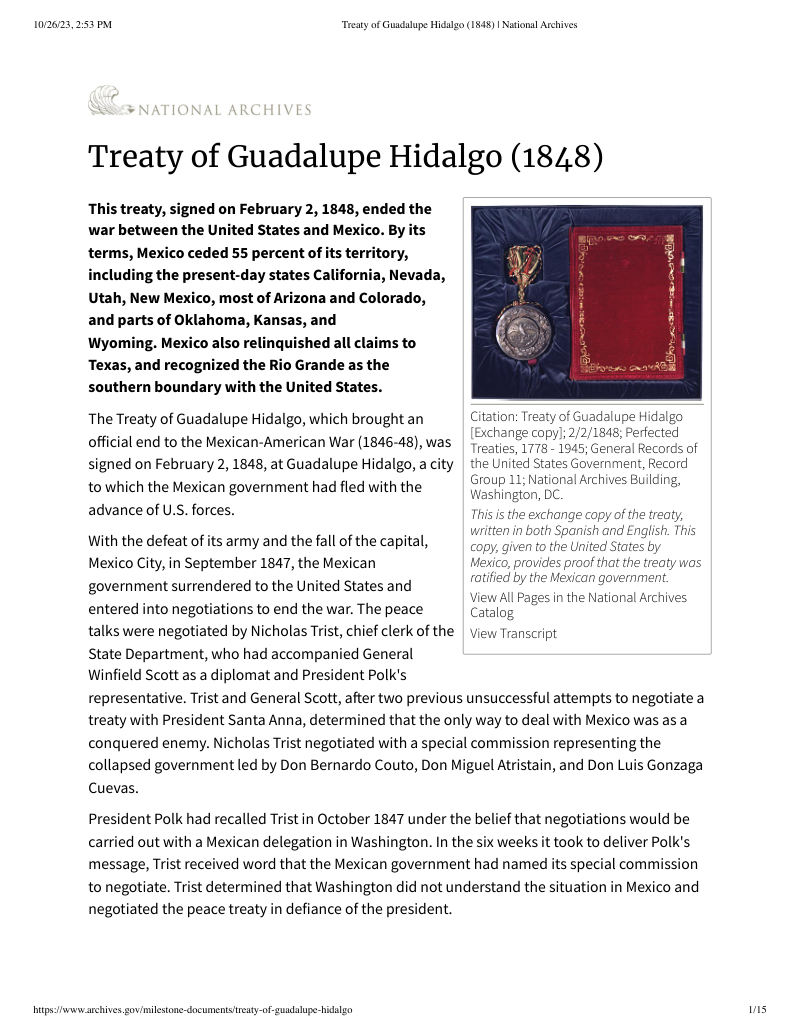Library of Congress gives description of the Treaty of Guadalupe Hildago and the United States' territorial gains.
- Type
- Website
- Source
- Library of Congress Non-LDS
- Hearsay
- Secondary
- Reference
"Treaty of Guadalupe Hidalgo (1848)," Library of Congress, accessed October 26, 2023
- Scribe/Publisher
- Library of Congress
- People
- Library of Congress
- Audience
- Internet Public
- Transcription
This treaty, signed on February 2, 1848, ended the war between the United States and Mexico. By its terms, Mexico ceded 55 percent of its territory, including the present-day states California, Nevada, Utah, New Mexico, most of Arizona and Colorado, and parts of Oklahoma, Kansas, and Wyoming. Mexico also relinquished all claims to Texas, and recognized the Rio Grande as the southern boundary with the United States.
The Treaty of Guadalupe Hidalgo, which brought an official end to the Mexican-American War (1846-48), was signed on February 2, 1848, at Guadalupe Hidalgo, a city to which the Mexican government had fled with the advance of U.S. forces.
With the defeat of its army and the fall of the capital, Mexico City, in September 1847, the Mexican government surrendered to the United States and entered into negotiations to end the war. The peace talks were negotiated by Nicholas Trist, chief clerk of the State Department, who had accompanied General Winfield Scott as a diplomat and President Polk's representative. Trist and General Scott, after two previous unsuccessful attempts to negotiate a treaty with President Santa Anna, determined that the only way to deal with Mexico was as a conquered enemy. Nicholas Trist negotiated with a special commission representing the collapsed government led by Don Bernardo Couto, Don Miguel Atristain, and Don Luis Gonzaga Cuevas.
President Polk had recalled Trist in October 1847 under the belief that negotiations would be carried out with a Mexican delegation in Washington. In the six weeks it took to deliver Polk's message, Trist received word that the Mexican government had named its special commission to negotiate. Trist determined that Washington did not understand the situation in Mexico and negotiated the peace treaty in defiance of the president.
In a December 4, 1847, letter to his wife, Trist wrote, "Knowing it to be the very last chance and impressed with the dreadful consequences to our country which cannot fail to attend the loss of that chance, I decided today at noon to attempt to make a treaty; the decision is altogether my own."
Trist sent a copy to Washington, and President Polk forwarded the treaty to the Senate for their advice and consent. When the Senate reluctantly ratified the treaty (by a vote of 34 to 14) on March 10, 1848, it removed Article X guaranteeing the protection of Mexican land grants. Following the ratification, the United States withdrew its troops from the Mexican capital.
With the annexation of more than 525,000 square miles of land, the Treaty of Guadalupe Hidalgo extended the boundaries of the United States west to the Pacific Ocean. This agreement, along with the 1853 Gadsden Purchase, created the southern border of the present-day United States.
The U.S. government paid Mexico $15 million "in consideration of the extension acquired by the boundaries of the United States" and agreed to pay American citizens debts owed to them by the Mexican government. Other provisions included the protection of property and civil rights of Mexican nationals living within the new boundaries of the United States, the promise of the United States to police its boundaries, and compulsory arbitration of future disputes between the two countries.
The B. H. Roberts Foundation is not owned by, operated by, or affiliated with the Church of Jesus Christ of Latter-day Saints.

